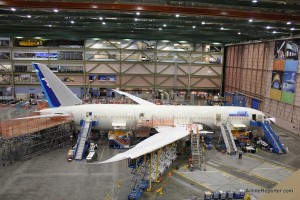
Boeing 787 Dreamliner for ANA in Boeing's factory. Photo by AirlineReporter.com.
Yesterday, I took a look how All Nippon Airways (ANA) and Boeing have worked together to prepare and train for the Boeing 787 Dreamliner. Today, we will explore how ANA directed some of the 787’s development and how their relationship with Boeing and other vendors will continue after they take delivery of the first Dreamliner.
ALL NIPPON AIRWAY’S INPUT
A large benefit of being the launch customer is that the airline gets to have influence over the development of the aircraft. ANA has been able to have a positive impact on the development of the 787 and Boeing has welcomed their input. Finding out how to make the 787 Dreamliner the best plane possible became a team effort. ANA reached out to employees throughout the company to determine what they would like to see in the new plane.
“ANA is much more than a customer for the 787 program. ANA has been a partner in helping us to make important decisions and in understanding our challenges and the solutions that have been developed,’ Scott Fancher, Vice President and General Manager of the 787 Program stated.
On many other aircraft, the front cockpit windows will open, allowing the crew to clean them if needed. The Dreamliner did not have opening windows, so ANA worked with Boeing to develop a window washer system, like you might find on a car that performs that function. ANA has also requested that Boeing develop oxygen masks that would better fit to the shape of Asian face.
EROS which is the manufacturer of the oxygen masks reviewed the data base to fit the various racial faces.
Most of the ideas proposed by ANA have been accepted by Boeing. ’œDuring our discussions, Boeing understood ANA’s requests,’ Mr. Kikuchi explained. ’œAlmost 70% of our unique requests have been implemented on the airplane.’
POST DREAMLINER DELIVERY
According to the most recent buzz, the first 787 Dreamliner is scheduled to be delivered to ANA as early as July 2011. Flight Global reports that the eighth 787 (ZA101) is currently set to be the first aircraft delivered to ANA, configured in a two-class, medium to short-haul set up. According to Boeing, they are not planning to sell the first three test planes, but do plan to sell the rest of the Dreamliners currently being used for testing.
Once Boeing hands over the keys of the first Dreamliner to ANA, the airline and aircraft manufacture will still have a very close relationship in continuing to assist with the development of the 787. For the first three months of ownership, Mr Kikuchi explained that Boeing and other vendors will support ANA strongly.
’œWe are working hard to finish our remaining requirements and look forward to a grand celebration of our first delivery with our good friends from ANA later this year,’ Boeing’s Fancher said. ’œThat delivery will be the first of many and each will be an opportunity to work together and celebrate our mutual accomplishments.”
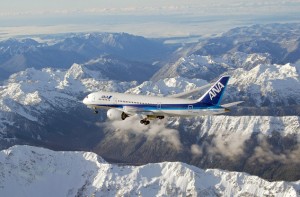
Boeing 787 Dreamliner ZA002 flying high with ANA livery. Photo by Boeing.
CONCLUSION
ANA is very pleased to be the first customer for the 787 and it shows. Much of their marketing has the Dreamliner prominently displayed and even their business cards have ’œ787, We Fly 1st’ printed on them.
All Nippon Airways already has a large presence with over 180 aircraft and over 70 destinations world-wide. They have flown many different types of aircraft since being founded in 1952; from DC-3s to Boeing 727s, they are no stranger to different aircraft types.
The Dreamliner will allow them to be the first to fly the next generation airliner and for many that is a very exciting prospect. It has to be even more exciting for the employees of ANA to know they have had such a direct impact with the 787’s development and that is something to be very proud of.
Talking to ANA About the 787 Dreamliner:
PART 1 | PART 2 | BOTH
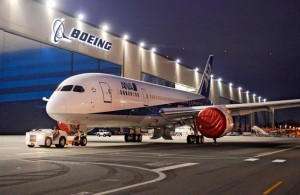
Boeing 787 Dreamliner in ANA livery at Everett Field. Photo by Boeing.
INTRODUCTION
Although the Boeing 787 Dreamliner looks similar to previous aircraft, it uses the next generation of technology and materials. Designing, building and then training for such a complex aircraft is no easy task. How does an airline go about preparing to take delivery of a brand new aircraft?
All Nippon Airways (ANA) will be the first airline to take delivery of the 787 and I recently had the opportunity to sit down with Mr. Takeo Kikuchi, ANA’s General Manager of the USA Engineering Office, and with Nao Gunji, ANA’s Communications Coordinator, to learn more about how they are preparing for the Dreamliner.
Today this story will give some background on the Dreamliner and the training that ANA has completed for the 787. Tomorrow, I will post about ANA’s input on developing the 787 and what happens after they take delivery.
I felt honored to have the opportunity to speak with Mr. Kikuchi. He started working in the airline business in 1980 as a mechanic and did heavy maintenance on classic Boeing 747s in Japan. Subsequently he was responsible for overseeing hydraulic systems on, allowing him to expand his engineering experience. He then worked in public relations for about three years before moving to Seattle in 2007 to lead the local ANA engineering office at Boeing.
Mr. Kikuchi’s main responsibility is to communicate to Boeing the needs of his airline and ensure ANA receives the best quality plane possible. ’œANA’s drive is to purchase a reliable, convenient and usable airplane,’ he explained.
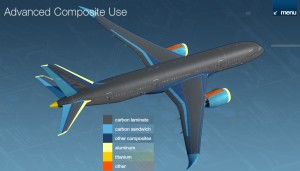
Graphic showing the different materials used in the Boeing 787 Dreamliner. From Boeing.com.
787 AIRCRAFT MATERIALS
The type of materials used is one way the 787 is unique from other aircraft (what makes the 787 different). Currently most aircraft are built using large aluminum panels and are riveted to a metal frame. In contrast, the 787 is constructed using large sections of mostly carbon composite materials that do not need to be riveted. Although the new material makes for a stronger and lighter aircraft, it can provide some challenges.
One of those challenges is how to repair the aircraft. To repair an aluminum aircraft, ANA puts a temporary patch on the affected area and then flies the damaged plane to their maintenance facility in Japan for a permanent repair. With carbon fiber, it is not as easy and will be more difficult to complete a temporary repair before flying to a repair facility. ANA is currently working with Boeing on perfecting the best way to make short-term repairs to the Dreamliner.
One advantage of a carbon fiber repair is the long term benefits. With an aluminum repair, an airplane will have additional squares of aluminum riveted onto the fuselage, causing additional weight and lowering aerodynamics ’“ raising fuel costs. After 787 composite repairs, the change of the aircraft weight and aerodynamics will be minimal, saving money over the lifetime of the airframe.
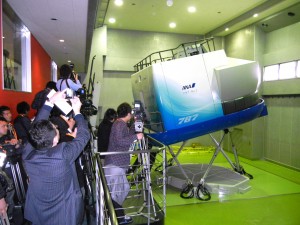
Japanese reporters getting a look at one of the two 787 full flight simulators in action at the Boeing/ANA training campus in Tokyo on March 7. Photo by Boeing.
ANA TRAINING
Although there are many forms of training, nothing beats hands-on experience. Mechanics have started with computerized training, but at some point will be flown from Japan to Paine Field in Everett, WA where the Dreamliner is built. To date, there have been over 100 ANA mechanics, who visit in groups of 10-12, who have been flown to Seattle to train on the Boeing 787 Dreamliner.
Even though there have been ANA pilots who have flown the Dreamliner, not all the pilots will have that chance before the airline takes delivery. The Japanese Civil Aviation Bureau (JCAB) approved Dreamliner simulators at the ANA/Boeing training campus in December 2010. ANA will start 787 pilot training as early as this month.
ANA has invested a lot of time, money and their future into the Boeing 787 Dreamliner and Boeing knows how important their relationship with ANA is. “I can’t say enough about Boeing’s special relationship on 787 crew training with ANA over the past four-plus years, ’ Sherry Carbary Vice President, Flight Services, Boeing Commercial Airplanes said. ’œTheir attention to detail was outstanding and made us better for it.’
After speaking with Mr. Kikuchi, I had a quick tour of the Boeing factory and the 787 production line (sorry, no photos). Now, I am no stranger to the factory, but this was much different tour being that I was guided by an airline representative and hearing their perspective.
While getting a tour of one of their 787 Dreamliners in production, we saw a group of ANA mechanics getting a quick look at the aircraft. Mr. Kikuchi told us that the mechanics would be given a scenario concerning a problem and they would learn how to solve it. It is one thing to talk about the 787 in a conference room versus being out with on the aircraft and seeing the mechanics in action.
Talking to ANA About the 787 Dreamliner:
PART 1 | PART 2 | BOTH




